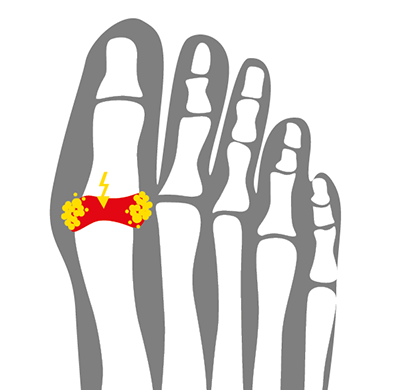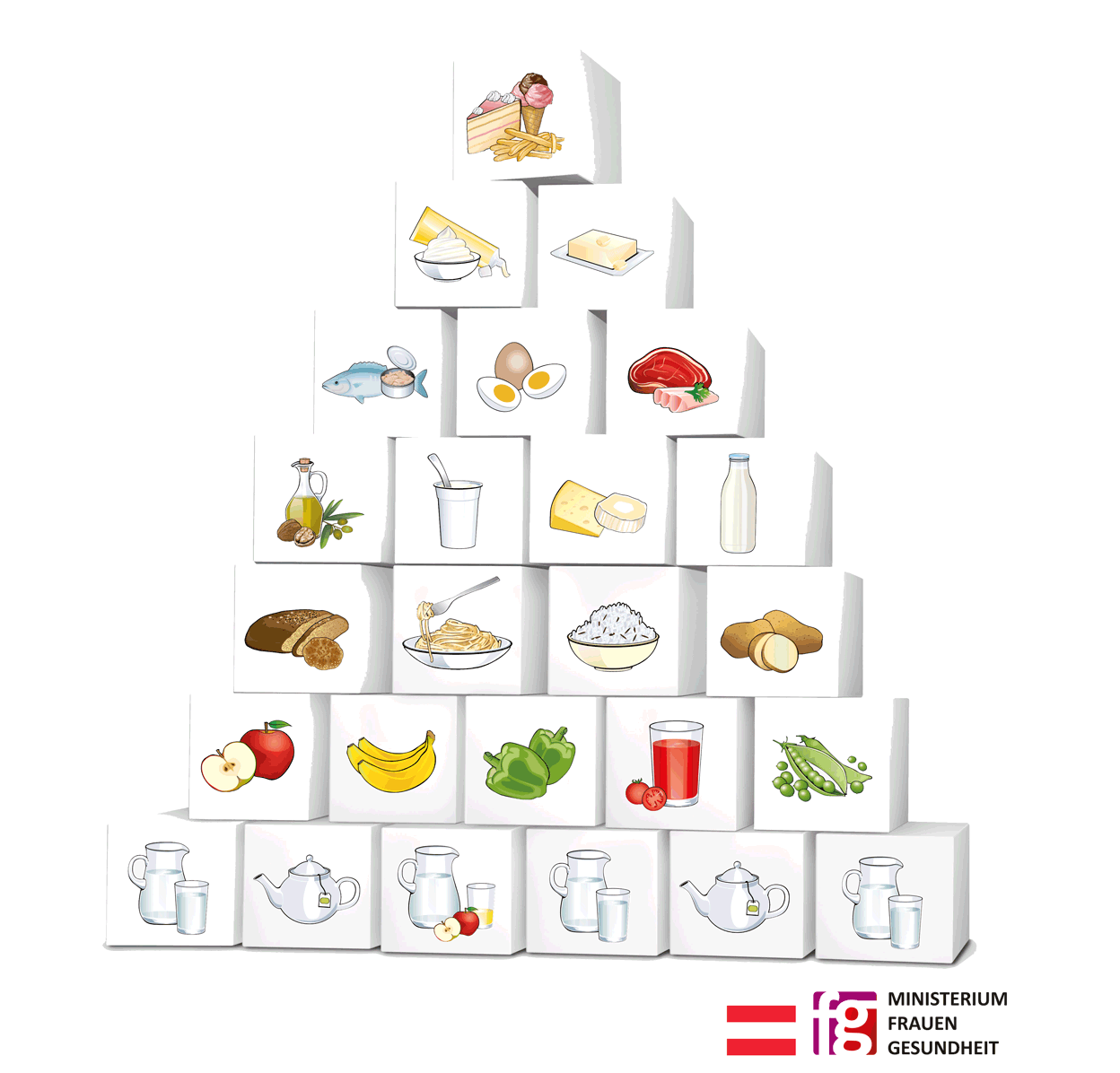Hyperuricaemia - elevated uric acid levels
Causes and consequences
Painful joint inflammation / gout
Uric acid is an end product from the protein metabolism and is mainly consumed with meat as a food component. At higher concentrations, crystals can form in the joints and cause inflammation; this is then called a gout attack, which can be very painful.
Uric acid is routinely determined during blood tests to diagnose gout or to control its course.
What is meant by elevated uric acid levels?
The specialist term for elevated uric acid is hyperuricaemia. You may be more familiar with the associated illness commonly known as gout. Gout occurs when the elevated uric acid in the blood crystallises and accumulates in the joints. This results in painful inflammation of the joints, most commonly in the big toe joint. Moreover, if the condition is chronic, uric acid also accumulates in the soft tissue and bone tissue, which is visible as gout nodules (tophi) on the finger joints, for example.
Hyperuricaemia occurs when the serum concentration is > 6 mg/dl for women and > 7 mg/dl for men.
How does hyperuricaemia occur?
Causes:
- high intake of purines via food
- impaired uric acid excretion
- increased cell breakdown e.g. due to rapid weight loss, or due to chemotherapy
Around 80% of uric acid is excreted via the kidneys and around 20% via the intestines. Impaired excretion can be traced back to different illnesses (e.g. dysfunction of the kidneys). Our society’s altered lifestyle (overeating, inactivity) is considered the main cause. This is why the illness often occurs together with metabolic disorders such as obesity, high blood pressure, elevated blood lipids and blood glucose levels. This is referred to as “metabolic syndrome”. Men are generally affected more often than women.
What effect does nutrition have?
Nutrition forms the basis for treating elevated uric acid levels, regardless of the cause of the hyperuricaemia. It should be a low-purine and plant-based mixed diet.
What are purines?
Purines are protein structures in food that are broken down into uric acid in the human body and excreted by the kidneys and intestines. Not all sources of purines lead to an increase in the serum uric acid concentration and/or reduced excretion.
Basic principles of nutritional therapy
- Reducing animal foods such as meat, sausage, offal and seafood
- Consuming low-fat food and dishes
- Avoiding consuming too much fructose
- Daily consumption of low-fat milk and low-fat dairy products
- Drinking enough fluids
- Avoiding alcohol
- Normalising your body weight
Through dietary measures, uric acid-reducing medications prescribed by a doctor may be reduced or discontinued. For the therapy to be successful, it should be considered whether other medications are being taken or whether there is increased cell breakdown, which can cause hyperuricaemia.
Reducing animal foods such as meat, sausage, offal and seafood
Meat and seafood are rich in purines and have a uric acid-increasing effect. Therefore, only eat meat and meat products (e.g. sausages, pies) up to 3x per week (1 portion equals 120g meat or 50g sausage). Offal (e.g. the liver, kidneys or heart) has a particularly high purine content and should therefore be avoided.
It is recommended to eat 120g fish 1 - 2x weekly because it is beneficial for the cardiovascular system. On the other hand, seafood and shellfish should only be eaten very occasionally.
Consuming low-fat food and dishes
A high fat consumption inhibits the excretion of uric acid via the kidneys and leads to increased levels of uric acid in the blood. Use low-fat foods and make sure to use (spreadable) fat and oils sparingly.
Daily allowance:
1 - 2 tablespoons of plant oil for meal preparation, for salad
max. 1 tablespoon spreadable fat
Avoiding consuming too much fructose
Fructose occurs naturally in fruit, and it is also often added to food and drink as a sweetener. Avoid fruit juices, smoothies and other sweetened drinks. A daily fruit consumption of max. 2 portions (= 2 handfuls) is not a problem. However, fruits that contain a lot of fructose, such as bananas and grapes, should be limited.
Daily consumption of low-fat milk and low-fat dairy products
Milk and dairy products can reduce the concentration of uric acid in the blood, while also being great sources of protein. Thus they are optimally suited to covering the daily required amount of protein. Consume daily 2 – 3 low-fat dairy products such as natural yoghurt, curd cheese, buttermilk and low-fat semi-hard cheese.
Drinking enough fluids
A fluid intake of at least 2 litres per day should be aimed for to increase the amount of uric acid excreted via the kidneys. Appropriate drinks are water, mineral water, and unsweetened herbal and fruit teas. Drinking coffee regularly can help lower the uric acid levels.
Avoiding alcohol
Alcohol should generally be avoided due to its uric acid-increasing effect. There are several reasons for this including the fact that consuming alcohol inhibits uric acid excretion, whilst also stimulating uric acid production in the liver. Beer (including alcohol-free beer) also contains purines that increase the concentration of uric acid in the blood.
Normalising your body weight
As obesity is associated with hyperuricaemia, gradual weight loss should occur. Losing weight also helps to improve the metabolic situation in cases of high blood pressure, elevated blood lipids and blood sugar levels. Crash diets should be avoided at all costs. Aim to steadily lose 0.5 – 1 kg per week through general changes to your lifestyle.
Pulses - beneficial or not?
Pulses (lentils, beans, peas, chickpeas, soya beans) and products made from pulses as well as several types of vegetables (such as spinach and broccoli) contain purines, however they do not have any effect on the uric acid concentration. Contrary to older recommendations, these foodstuffs should not be limited. However, combining them with animal sources of purines, such as meat, should be avoided.
Practical tips
Remove the skin from fish and poultry, and the rind from pork.
It is preferable to prepare meals with a small amount of meat e.g. rice with meat or chilli con carne.
Avoid smoked products, as the smoking process increases the purine concentration
Eat meat less often by replacing some of these dishes with vegetarian meals based on grains/cereal products and vegetables.
Consume 3 portions of vegetables/salad every day and max. 2 portions of fruit daily
(1 portion = 1 handful) - this helps you obtain the required amount of vitamin C. Vitamin C helps to reduce uric acid. Food rich in vitamin C includes citrus fruits, strawberries, sweet peppers, leafy vegetables, cabbage and spinachEat vegetable soup instead of meat or bone broths, as purines are water soluble.
Avoid ready-made seasoning, sauces and bouillon cubes made from meat. Instead use stock cubes made from vegetables without yeast extract or fresh herbs and vegetables as seasoning.
Choose low-fat cooking methods such as boiling, stewing, steaming, roasting in a little oil or cooking using a steamer
Choosing Food
| Recommended | Not recommended |
|---|---|---|
Drinks | Water, (sparkling) mineral water, soda with lemon, unsweetened herbal/ fruit tea > At least 2 liters daily | Fruit juices, smoothies, lemonade, ice tea, flavoured mineral water, energy drinks; |
Vegetables, pulses, mushrooms | All types of vegetables prepared naturally or raw, salad as a side dish, pulses, mushrooms | Fat-free cooking e.g. preserved/breaded vegetables; |
Fruit | All types of raw or prepared fruit e.g. compote | Large amounts of fruits that contain a lot of fructose (such as bananas, grapes and cherries) |
Grains & cereal products, potatoes | Bread, baked goods, pasta, rice, dumplings, polenta, couscous, millet, buckwheat,... > preferably wholegrain varieties, potatoes | High-fat potato preparations such as chips and croquettes |
Milk & dairy products | (Fat-free) milk and dairy products such as natural yoghurt, curd cheese, buttermilk, fermented milk, kefir, skyr | Dairy products with fruit such as fruit yoghurt or fruit buttermilk; |
Fats & oils | Moderate use of plant oils for food preparation and salads, as well as spreadable fat | Clarified butter, lard, bacon spread |
Meat & meat products | Lean meat from poultry, beef, veal, pork,... | Poultry skin, pork rind; |
Fish, seafood & shellfish | All types of fresh fish, both lean and high-fat | Seafood, shellfish, fish skin, tinned fish, smoked fish |
Eggs | 3 eggs / week | High-fat egg dishes such as ham & eggs |
Ready-made products, yeast, sweets & snacks | Low-calorie desserts such as natural curd cream with fruit, apple strudel made with wafer-thin strudel dough, home-made pudding; sweets/snacks in moderation | Ready-made products, ready-made seasoning and sauces; products containing a lot of yeast e.g. spice mixes with a yeast base; |
This table does not claim to be complete, but should serve as a suggestion and for brainstorming.
Ideas for vegetarian dishes
Cold meals
- Medium-fat semi-hard cheese (35% fat content) with bread and vegetables (tomatoes, sweet peppers, chillies, pickles)
- Curd cheese spread (Liptauer cheese spread, egg/herb/pumpkin seed/horseradish spread) with wholemeal bread and vegetables
- Chickpea, lentil or bean spread with bread
- Hard/soft-boiled egg with bread and vegetable sticks
- Tomatoes and mozzarella with Graham bread
- Greek salad with feta and ciabatta
- Pasta/grain salad with cheese or egg and vegetables
- Bean/lentil/chickpea salad with baked goods
- Porridge with fruit and nuts
- Semolina pudding/rice pudding with unsweetened compote/fruit purée
Hot meals
- Spaghetti with tomato sauce or courgette carbonara
- Stuffed courgettes with potatoes
- Pumpkin with fried polenta
- Fisoleneintopf (green bean stew) with bread
- Lentils and vegetables with bread dumplings
- Creamed spinach with roast potatoes and a fried egg
- Strudel made from wafer-thin strudel dough with various fillings such as vegetables, spinach and feta, cabbage or pumpkin
- Vegetable, spinach or pumpkin lasagne
- Egg dumplings with a green salad
- Krautfleckerl (pasta with white cabbage) with salad
- Vegetable rice with pan-fried tofu
- Potato and broccoli casserole
- Chickpea curry with rice
- Vegetable patties with herb sauce and parsley potatoes
- Potato goulash
- Curd cheese pancakes with unsweetened compote
- Apple baked rice pudding


